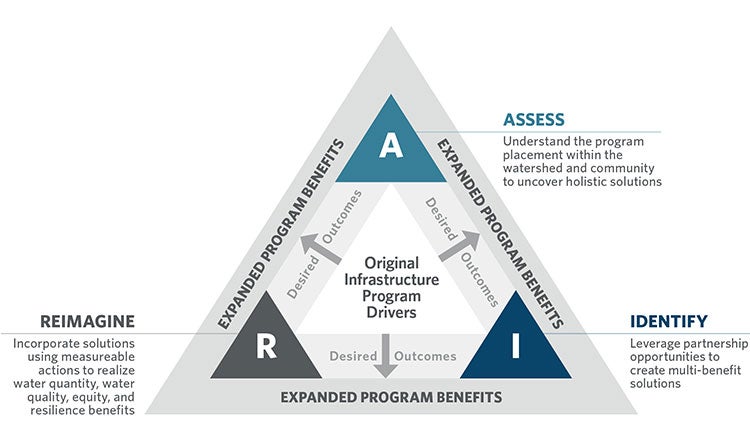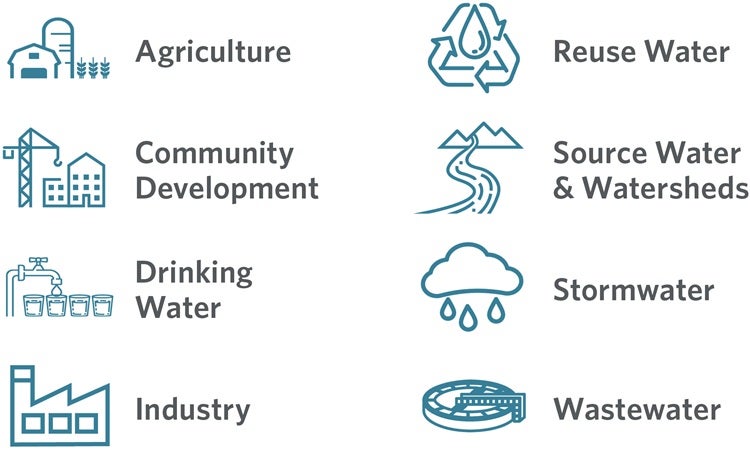
Discover and Expand Multiple Benefits by Applying a One Water Perspective
Using the “A-I-R” Process to Operationalise One Water
Applying a One Water perspective to identify multiple benefits helps utilities look beyond the core water infrastructure needs and uncover opportunities to deliver broader environmental, community and economic value. This integrated approach supports a more sustainable future by advancing equitable and affordable water access, strengthening water supply resilience, improving wastewater reliability, enhancing flood protection, and promoting healthy ecosystems that contribute to long-term community and regional prosperity.
To maximise the value and impact of a project or programme, consider refining its scope to integrate the One Water perspective. By applying the “A-I-R” process — Assess, Identify and Reimagine — outlined in Figure 1 and detailed in the following text, teams can discover and activate these expanded benefits, transforming traditional approaches into innovative, multidimensional solutions.

The first step in the A-I-R process is to assess the scale of the project or programme and understand its placement within and its influence on the broader community, catchment and region. Consider how it is influenced by conditions at multiple levels, including regional catchment, community, programme, and individual project. Evaluating opportunities across these scales helps uncover potential benefits and challenges that may not be apparent. For instance, while the rehabilitation of a facility may appear to be a project-level activity, its location within an underserved community creates a community-level opportunity to engage stakeholders, design for broader social benefits or select alternatives that reduce adverse impacts. The facility may also affect or be affected by even broader considerations, such as shared permitting at the regional catchment level. It is important to view the programme through a wider lens and explore cross-scale connections to identify more holistic, equitable and effective solutions.
Next, identify opportunities for interagency and intra-agency collaboration to strengthen project and programme implementation, as well as amplify community and regional benefits. Begin by reviewing the entities operating within the programme’s geographical area of influence as shown in Figure 2, including those involved in source water protection, catchment management, drinking water, stormwater, wastewater, reuse water, agriculture, community development, and industry.

Engage diverse perspectives and explore potential partnerships to shape a project or programme scope that addresses environmental and community priorities while enabling multi-benefit solutions. Coordinating efforts across sectors and water utilities within the same catchment can enhance efficiency, lower costs and lead to more resilient, integrated and sustainable outcomes.
Finally, reimagine solutions by identifying and implementing measurable actions that optimise the project or programme scope and deliver multiple water quantity, water quality, equity and resilience benefits. Traditionally, projects and programmes are designed to address specific needs, such as increasing water supply through storage or water reuse projects or meeting regulatory water quality requirements; however, growing climate risks and evolving community expectations have highlighted the need for integrated, resilient and equitable solutions. Today’s projects and programmes must also prioritise affordability and service equity, especially in historically underserved and rural areas.

To realise these broader outcomes, it is essential to define and track measurable actions linked to the project or programme’s benefits. Capturing these benefits allows teams to establish clear key performance indicators, drive delivery accountability and highlight the tangible value of the project or programme. This benefits-driven approach fosters transparent communication with partners, stakeholders and communities, ensuring alignment and trust while building a strong foundation for long-term sustainable success. By prioritising measurable results and meaningful engagement, you can elevate the impact of your efforts and create lasting value.
We work with water stewards to help them operationalise One Water. If you want to apply the A-I-R process to your next project or programme, please jacquelin.mutter [at] hdrinc.com (reach out).





